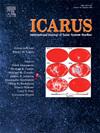Volcanic gas plumes’ effect on the spectrum of Venus
IF 3
2区 物理与天体物理
Q2 ASTRONOMY & ASTROPHYSICS
引用次数: 0
Abstract
Venus is home to thousands of volcanoes, with a wide range of volumes and sizes. Its surface is relatively young, with a temperature of approximately 735 K and an atmosphere of 92 bar. Past and possible ongoing volcanic outgassing is expected to provide a source to the sustenance of this massive atmosphere, dominated by CO and SO. The lower atmosphere can be investigated in the near-infrared transparency windows on the nightside, such as the thermal emission window, which provides a chance of detection of species with volcanic origin, such as water vapor.
The Planetary Spectrum Generator was used to simulate the nightside thermal emission window of Venus. We simulated the effect of a volcanic gas plume rising to a ceiling altitude, for species such as HO, CO, OCS, HF and SO. The sensitivity of the radiance spectrum at different wavelengths was explored as an attempt to qualitatively access detection for future measurements of both ground-based and space-instrumentation.
We conclude from our qualitative analysis that for the HO, CO and OCS plumes simulated there is potential to achieve a detection in the future, given a minimum required signal-to-noise ratio of 50. For SO and HF plumes, a higher signal-to-noise ratio would be needed.
火山气体对金星光谱的影响
金星上有成千上万座火山,它们的体积和大小各不相同。它的表面相对年轻,温度约为735 K,大气密度为92巴。过去和可能正在进行的火山喷发预计将为这种以二氧化碳和二氧化硫为主的巨大大气提供维持物质的来源。低层大气可以通过近红外透明窗口(如2.3μm热发射窗口)进行研究,该窗口提供了探测火山成因物质(如水蒸气)的机会。利用行星光谱发生器模拟金星的夜侧2.3μm热发射窗口。我们模拟了上升到天花板高度的火山气体羽流对H2O、CO、OCS、HF和SO2等物质的影响。对不同波长辐射光谱的灵敏度进行了探讨,试图定性地获取探测,以便将来进行地面和空间仪器的测量。我们从定性分析中得出结论,对于模拟的H2O、CO和OCS羽流,如果要求的最小信噪比为50,则有可能在未来实现检测。对于SO2和HF羽流,需要更高的信噪比。
本文章由计算机程序翻译,如有差异,请以英文原文为准。
求助全文
约1分钟内获得全文
求助全文
来源期刊

Icarus
地学天文-天文与天体物理
CiteScore
6.30
自引率
18.80%
发文量
356
审稿时长
2-4 weeks
期刊介绍:
Icarus is devoted to the publication of original contributions in the field of Solar System studies. Manuscripts reporting the results of new research - observational, experimental, or theoretical - concerning the astronomy, geology, meteorology, physics, chemistry, biology, and other scientific aspects of our Solar System or extrasolar systems are welcome. The journal generally does not publish papers devoted exclusively to the Sun, the Earth, celestial mechanics, meteoritics, or astrophysics. Icarus does not publish papers that provide "improved" versions of Bode''s law, or other numerical relations, without a sound physical basis. Icarus does not publish meeting announcements or general notices. Reviews, historical papers, and manuscripts describing spacecraft instrumentation may be considered, but only with prior approval of the editor. An entire issue of the journal is occasionally devoted to a single subject, usually arising from a conference on the same topic. The language of publication is English. American or British usage is accepted, but not a mixture of these.
 求助内容:
求助内容: 应助结果提醒方式:
应助结果提醒方式:


